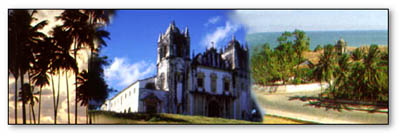|
      

|
 Although Recife is the fourth-largest
city in Brazil, it is less modern and cosmopolitan than its more famous
counterparts. Recife and its environs have only recently become a
tourist destination, so visitors are often a novelty for its
inhabitants, especially those of the neighboring fishing villages. Although Recife is the fourth-largest
city in Brazil, it is less modern and cosmopolitan than its more famous
counterparts. Recife and its environs have only recently become a
tourist destination, so visitors are often a novelty for its
inhabitants, especially those of the neighboring fishing villages.
Recife's name was derived from the Portuguese word for reef, referring
simply to the city's situation behind a long and protective coastal
reef. Recife is a major port city, and much of its energy and culture
has its source in the constant influx and outflow of trade. High rises,
colonial churches, and markets quilt the city with a mix of old and new.
Often called the Venice of Brazil for its many canals, bridges, and tiny
one-way streets, Recife is a wonderful city in which to wander about,
letting chance provide a memorable discovery or two.
 The
wealthy Boa Viagem district provides a good home base. This waterfront
area is Recife's real center, possessing both the city's
finest beach and a wealth of fine restaurants. Much of Recife's
nightlife is here, as well as in Gracas. From there, the old city can
be explored as well. Beginning at the Praca da Republica, one can visit
the
impres- sive, 19th-century Teatro Santa Isabel and proceed to the
Catedral de Sao Pedro dos Clerigos. After passing through the
colorful Mercado do Sao Jose -Saint John's Market- visitors can
wind up a walking tour of the old city at the Basilica de NS da Penha. The
wealthy Boa Viagem district provides a good home base. This waterfront
area is Recife's real center, possessing both the city's
finest beach and a wealth of fine restaurants. Much of Recife's
nightlife is here, as well as in Gracas. From there, the old city can
be explored as well. Beginning at the Praca da Republica, one can visit
the
impres- sive, 19th-century Teatro Santa Isabel and proceed to the
Catedral de Sao Pedro dos Clerigos. After passing through the
colorful Mercado do Sao Jose -Saint John's Market- visitors can
wind up a walking tour of the old city at the Basilica de NS da Penha.
Recife's deep cultural roots are notable, and its traditional cultural
activities should not be over- looked. Recife is one of Brazil's
richest places to explore folk art and craft, including music, dance,
sculpture, and painting. Its traditional handicrafts include clay
figurines, wood sculptures, leather goods, and woven straw, all to be
found at festivals and markets around the city as well as at the Casa
da Cultura de Recife -Recife's Cultural Centre.
Copyright (c)
1998 - 2006 interKnowledge Corp.
All rights reserved.

|
|
|

